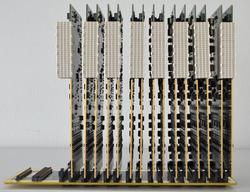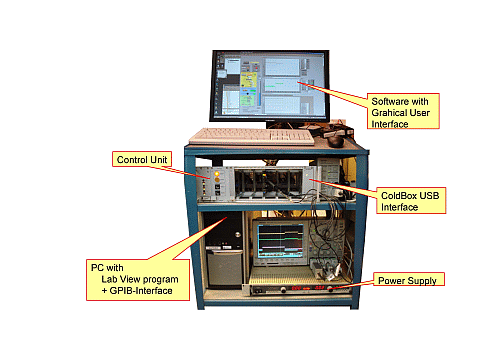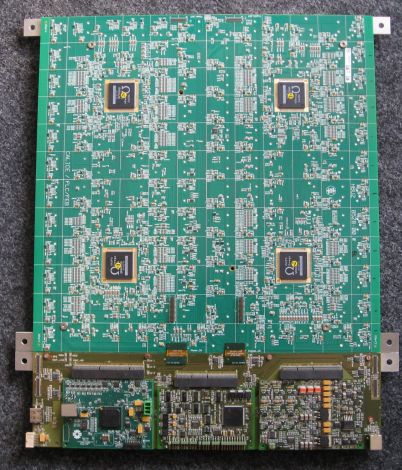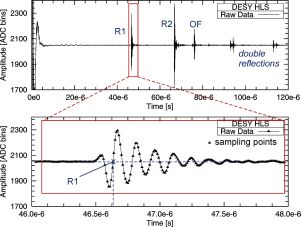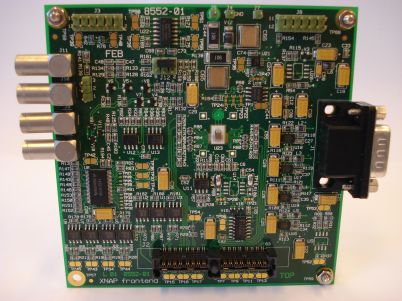URL: https://fe.desy.de/sites/site_fe/content/feb/projects/@@siteview
Breadcrumb Navigation
FEB - Projects
|
Analogue cards for AGIPD - a one-Megapixel, 4.5MHz camera |
|
|
The European XFEL has a bunch to bunch time interval of 222ns. |
|
|
Links to further documents
|
|
|
Cold box for testing Silicon detectors |
|
|
The LHC experiments will operate the silicon trackers at freezing temperatures. |
|
|
CALICE AHCAL: Electronics for a high granular hadronic calorimeter |
|
|
The group FEB currently develops within the CALICE collaboration the prototype of a tile hadron calorimeter (HCAL) for the International Linear Collider (ILC). The prototype utilizes scintillating tiles that are read out by novel Silicon Photomultipliers (SiPMs). The full prototype will contain about 2200 detector channels (one layer) and takes into account all design aspects that are demanded by the intended operation at the ILC.
|
|
|
Hydrostatic Leveling System |
|
|
For the PETRA-III beamline at DESY, the group FEB has developed the complete operational electronics for a hydrostatic levelling system (HLS). The HLS is based on a long, horizontal pipe that is connected to beamguiding components of PETRAIII and that is filled to one half with water. At specific metering points, the water surface is measured by the generation of ultrasound pulses and the measurement of their reflections at the water surface. By a special reference system within the metering points three reflections are produced (see figure), which allows an automatic temperature compensation. The ultrasound reflections are measured with a 12-bit and 100MHz ADC, which allows a sufficient time resolution (better than 1ns) for accuracies of the measured water levels of about 1µm. The control electronics is based on ARM7 microcontrollers and fast FPGAs.
|
|
|
XNAP: Test board for a multichannel APD with readout ASIC. |
|
|
The board is designed as a cheap adapter to support a structure of an APD-area-sensor, an interposer and an ASIC. |
|
|
Documents and further information
|
|
|
|
|
|
Fast Pulse Masker |
|
For beam studies at VUVFEL it is required to kick out individual bunches. For these short time periods signals from a few photomultipliers have to be disabled. The basic functionalities of the electronics are:
|
|
|
|
|
|
Laser synchronization to TTF1-Beam |
|
|
To measure optical effects synchronized to the bunches of the electron beam, pulsed lasers have to be stabilized in time. For measuring the longitudinal beam profile of TTF-I with electro-optical-sampling (EOS) electronics has been developed, which synchronizes the phase of a 81MHz infrared laser to the 1.3GHz master oscillator of the accelerator. |
|
|
|
|
|
Beam Stabilizer for Photon Beams at HASYLAB (DMOSTAB) |
|
|
HASYLAB provides X-ray test beams.The beam parameters are adjusted with a voltage supplied to a pieco-crystal. Changing the voltage turns a X-ray reflection crystal. This allows to control the beam intensity, the energy of the photons and the energy spread. |

|
|
|
|
|
Multichannel Temperature Monitor and Alarm System for HERA |
|
|
The beam pipe of HERA is strongly heated by synchrotron radiation. To avoid damages of the pipe, the temperature needs to be monitored and might have to trigger a beam dump. The sensors are distributed around the HERA-ring. So the electronics has to cope with varying ground potentials, long signal cables and routing of signal lines parallel to high current cables. Therefore electronics close to the sensors converts the temperature into a frequency. This allows to transfer the information over the long distances as digital signals. A phase locked counting avoids the pick up of noise from the 50Hz power lines. |
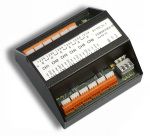
|
|
Transient Recorder for HERA and PETRA |
|
To optimize the performance of the HERA accelerator also rare effects like unusual voltages and digital patterns, temperatures etc. have to be monitored. Pulse shapes of corresponding signals have to be recorded before and after the time of identification. This is simultaniously done with a common time stamp at a large number of locations distributed over the whole areal of HERA. All data are written to a common archive and can be analyzed offline. The design can be upgraded to an infinite number of channels. Also a synchronization with the HERA revolution time is possible.
|
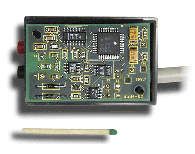
|
|
Radiation monitors for D3 |
|
|
In the DESY areal in Hamburg and in future at the photon gun in Zeuthen the radiation level has to be monitored. Long term protocols are written to a data base and spikes or high levels interlock the operation of the accelerators. |
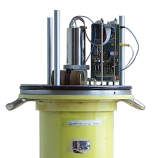
|


